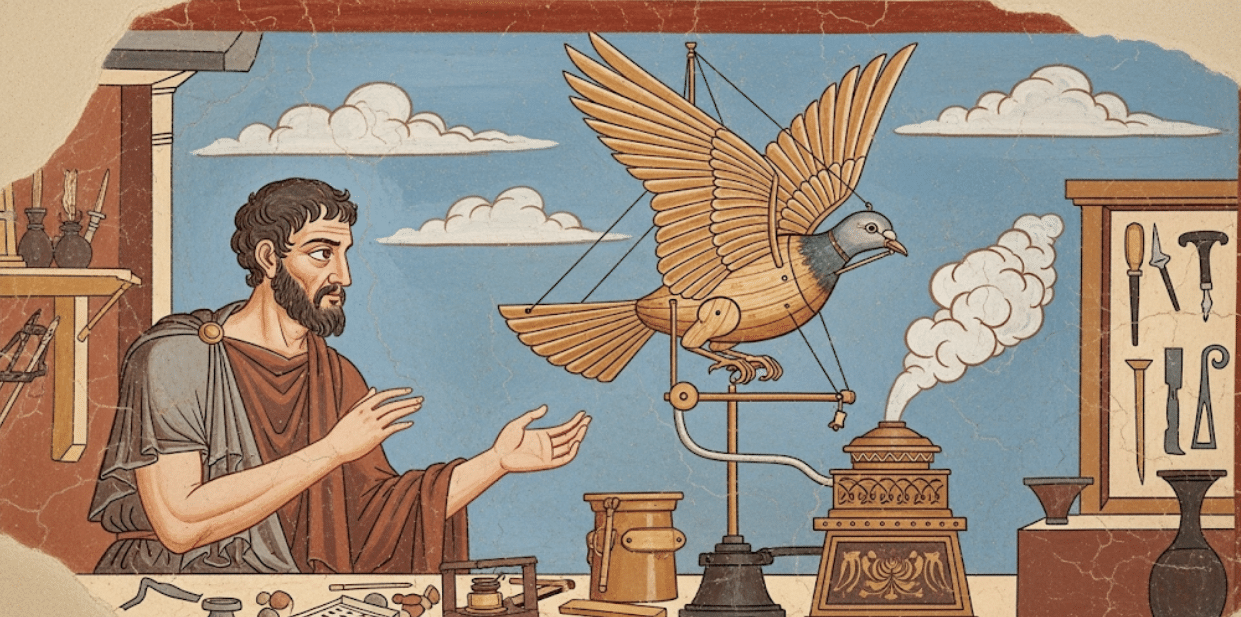Ancient Greek Genius Archytas Built a Flying Machine 2,400 Years Before Drones
Source: GreekReporter.com

Without exaggeration, long before the first drone tore through the skies, and centuries before Leonardo da Vinci sketched his flying machines, an ancient Greek thinker, Archytas, built one of the first-ever flying machines.
In the ancient city of Tarentum, in what is now southern Italy, this ancient Greek polymath engineered a wooden pigeon that actually flew—powered by steam. It was a staggering achievement that tells you everything you need to know about a civilization that wasn’t just preoccupied with philosophical debates but was also driven to advance human knowledge and achievement.
Who was Archytas, who built one of the first flying machines ever?
It is easy to get lost in the legend of the flying pigeon, Archytas’ flying machine. When so much time passes, details inevitably grow a bit blurry, so it’s important to stick to what we actually do know. Archytas was one of the most significant figures of his time in Greater Greece (Magna Graecia , in modern-day southern Italy). As a brilliant statesman and seven-time elected general of Tarentum—a city that was a major power in the broader region—in the 5th century BC, being elected so many times consecutively was virtually unheard of. This demonstrates the immense trust his people had in him. However, it was his mind, rather than merely his political acumen, that made him truly remarkable.
As a Pythagorean, he believed the universe was governed by numbers, and he put that belief into practice. He solved the “Delian problem,” a famous mathematical puzzle involving the doubling of a cube’s volume, which was a significant challenge at the time. His solution was the result of geometric genius that earned him well-deserved fame. Thus, when he built his steam-powered bird, he treated it as the ultimate demonstration of his worldview—that, through mathematics, man could replicate the miracles of nature.

From a flying pigeon to modern robotics
So what does a 2,400-year-old wooden bird that once flew have to do with us today? The answer is more than one might expect.
The vision of Archytas fundamentally shaped our world by proving that mechanics is a creative force that could drive humanity forward. He founded the field of mathematical mechanics, bridging the gap between abstract theory and real-world applications through tangible inventions. That ancient pigeon, described by the Roman writer Aulus Gellius as being propelled by a jet of steam, was the ancestor of every modern engine, drone, and robot.
Although this may sound like an exaggeration, it truly is not. It was the first time someone demonstrated that inanimate objects could be intentionally designed to move using scientific principles. This marked a shift away from abstract theories of possibility toward practical, real-world applications—and a radical departure from a world shaped by gods, supernatural beliefs, and magic. In essence, it signaled the birth of technology as we know it—a worldview in which understanding the laws of nature empowers us to create remarkable things that can transform society. Archytas’ flying pigeon machine was, of course, not one of these, but it did lay the groundwork for everything that followed.

The man who made a machine fly
It is tempting to dismiss the whole mechanical pigeon story as a myth, but the work of Archytas was grounded in real science. He applied his deep knowledge of geometry, proportion, and physics to real-world applications. The pigeon may have flown only for a short while, but the doors it opened to human knowledge were very real. He demonstrated that human ingenuity was not limited to philosophy and art but could be harnessed to create engineering marvels that shaped the world around us.
What makes this all the more remarkable is that it all happened in an era far removed from modern scientific thinking. Against all odds, Archytas conceived of and built a self-propelled automaton. In doing so, he posed a fundamental question about the limitless potential of the human mind.
The original article: belongs to GreekReporter.com .
